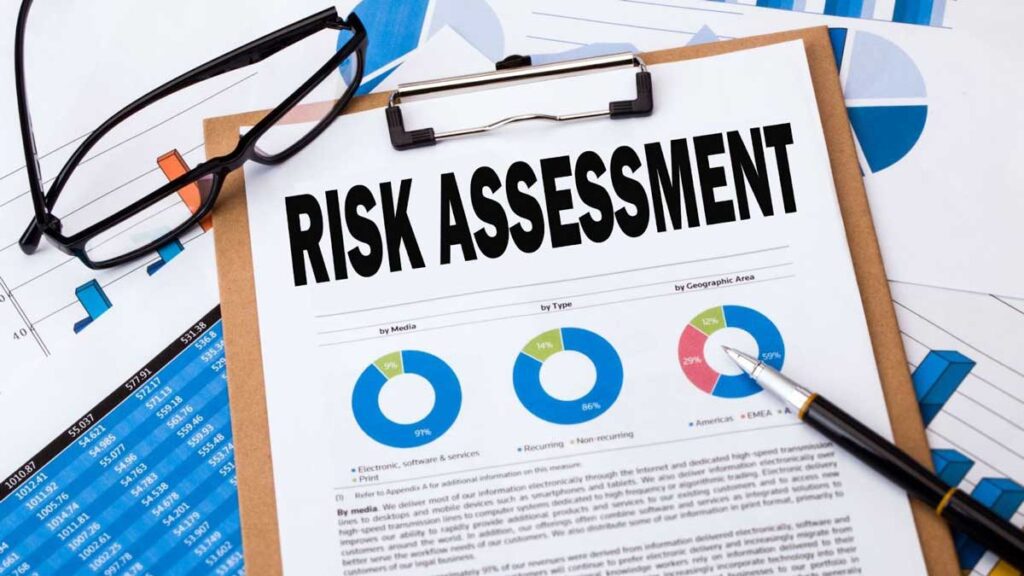
Risk exists in every business. It’s critical to recognize the risks to your company and take steps to manage risk in business. By describing how you handle risks to your firm, a risk management plan helps you accomplish this. You can ensure a secure workplace and lessen the likelihood of detrimental effects on your company by devoting time and resources to designing your risk management strategy.
Want to learn how to manage risk in business? Here are the 15 effective ways to manage risk in business.
1. Determine A Risk

Identifying potential risk factors before making any decisions is one of the most crucial things you can do in risk management. When beginning a new career, relocating, purchasing a new home, starting a new business, or growing, this is crucial.
Risks frequently catch us off guard because we are initially unaware that they even exist. As a result, we lack the capability to manage the possibility of this major factor. It’s always a good idea to do your research before deciding to do something new, even if it’s only something as minor as having a disagreement with a coworker.
You must assess your behavior to find any risks that could harm your business, way of life, or career. What if? is what you should be asking yourself here. It involves ironing out the kinks to see what might go wrong as a result of an event that has happened or is about to happen as a result of your decisions.
2. Evaluate The Risk
The next stage after identifying potential risks is to evaluate the risk’s impact in order to make deliberate actions that will lessen the risk’s impact. For instance, you might be debating increasing your cryptocurrency purchases or reducing your holdings.
You would need to think about the consequences of your decision to buy if you wanted to make more purchases. This includes information such as the likelihood that market forces may cut your profits, the likelihood that a certain cryptocurrency will survive, the ideal moment to sell and acquire, and a lot more. When making a significant decision like this, traders only take a few factors into account.
They weigh the benefits and drawbacks of these phenomena to determine whether it is worthwhile to continue.
Stocks may be soaring right now, but what if they start to fall? In order to make the greatest choice, these questions need to be considered in their overall context.
By determining the chance of it happening and the results if it does, you may assess the level of risk associated with each action or event. That is the action’s impact and frequency.
Level of risk = likelihood X consequences
Consider using a likelihood and consequence rating scale with a scale of 1 to 5.
1 is the least harmful and least likely to happen, while 5 is the most harmful and most likely to happen.
3. Observe Or Track The Risk

The process of safeguarding your interests in the event of risk is ongoing after setting up an insurance plan. You must make sure that your insurance plan is still in place and working to reduce risks. To make sure that your insurance plan covers your risk, for instance, you could contact your insurance provider. You can check in with the parties you contracted out the risk to see how they’re handling it.
To maintain composure, you must make sure that you are in the driver’s seat. For instance, there is a chance that your new firm will fail if you decide to launch it. A wise move would be to regularly train the staff, guarantee the quality of the product or service, keep an eye on any issues that could hurt your company, and establish plans to either avoid them or lessen their impact.
When formulating methods to make sure that measures are taken to minimize its impact and lessen its chance, you can be original and creative. Your business goals may be related to reducing the risk’s impact if you put some effort into that. You might also think about letting your colleagues and coworkers know about the danger in order to provide them with practical advice on risk mitigation while also taking precautions to avoid it.
4. Get Risk Insurance
Risk insurance is designed to mitigate the effects of risk and determine which risks are acceptable. You could balance the benefits and drawbacks of accepting the risks and the level of risk by calculating it. You might choose to take a certain amount of risk knowing that the advantages exceed the drawbacks. When the risk is modest, you might also choose to follow through on a plan of action.
Another indication to take the risk is when you can confirm that the benefit of the risk outweighs the cost of addressing any potential damage. You may choose to move forward now that you have determined the risk, the possibility that it will occur, and the potential consequences.
You need to protect yourself from the possible fallout of any risk you take when doing so for either of these reasons. You must therefore work to prevent it from happening, minimize its effects, and overcome it if it does. Reduce the possibility and impact of the risk if it cannot be eliminated.
For instance, traders of equities and cryptocurrencies frequently set a stop limit. When the price of a stock or cryptocurrency drops, a trader sells it off at the stop limit. A sell order, which instructs them to sell after they have made the desired profit, is another option. They prepare for possible price declines and are aware that they might experience one.
Transferring the risk of a contract to another party is an additional risk management strategy. For instance, you might decide to purchase auto insurance due to the possibility of having your vehicle stolen.
The greatest risk of the car being stolen or getting damaged belongs to the insurance company. A highly risky business may potentially be contracted out to a third party, who would complete the task while paying you a commission. For instance, as an events manager, you can think about hiring others to handle the catering and decorations in exchange for commission payments while you take on the risks.
Planning ahead to lessen the impact of a risk by taking actions to safeguard your interests is essentially the emphasis of insurance. However, if the dangers turn out to be too great, the expense of treatment will also be too great, and there won’t be any way to insure against it. You should think about another option.
5. Prioritize

Prioritizing risks that require attention is important when building a risk management plan. This implies that you list potential risks associated with an action and address them in terms of their seriousness and urgency.
It may be complicated and difficult to contain all the risks if a problem is approached from too many angles. Naturally, you want to eliminate all risk factors as quickly as possible, but hurrying decisions and disregarding priorities might lead to unintended consequences.
6. Remain Informed
As they say, information is power, and information is also the basis for efficient risk management. You must constantly be on the lookout for fresh facts that can influence your choice or the likelihood and impact of a risk.
A judgment that could endanger your interests is less likely to be made when you are informed and continually pursuing education about your trade (market forces), business (innovation), and other topics. If you are informed about what you are doing and the best approach to take, there will be few setbacks.
So that you are prepared to solve any problems that arise. Because you don’t have a lot of information and can’t keep up with the risks, it frequently occurs.
7. Expand The Range Of Your Products
Keep in mind the saying, “don’t put all of your eggs in one basket”?
Diversifying your company’s offerings is a terrific idea, whether you’re selling goods, services, or both. This not only enables you to provide more options to your consumers, but it also enables you to have many sources of money.
The public’s interest in your business is also maintained by diversifying your products or services. It may also provide you with an advantage over rivals.
It’s time to expand your product or service offerings if your company just offers one. Make sure every new good or service you offer is of the finest quality, as well.
8. Do Your Own Research At All Times
You must do your own research and refuse to accept statements at face value. If someone approaches you with an investment opportunity, you should do your own research before starting the firm.
You must realize that marketers would maximize the profit and ignore the drawbacks. However, you should first carry out an in-depth investigation before making any purchases of stocks and cryptocurrencies. Don’t just jump in without doing your research.
Maintaining your knowledge by reading books will help you reduce any dangers associated with your assets
9. Your Business Loan Should Be Kept To A Minimum

Many businesses always obtain business loans because they are so appealing. They might give you enough money to start or grow a business, but they also carry risks for that business.
If acquiring a company loan is unavoidable, be sure it’s manageable and has the lowest interest rate possible. Make sure you can genuinely afford the monthly payments by comparing plans from other banks in advance.
Don’t forget to only request a loan if you actually need one. If not, just concentrate on marketing your company. This will decrease your financial risk for you and boost sales.
10. Let Logic Lead The Way Rather Than Emotions
You might have come across the term “weak hands.” Weak hands refer to traders who are quick to exit the market or sell off their stocks or cryptocurrencies at the slightest hint of a dip. These same people are quick to enter the market when they sense a bullish run. Although they may manage certain downhills and make some profits, in the long run, this is not sustainable.
Weak hands follow their instincts rather than reason. Weak hands follow their emotions of fear and excitement instead of using market analysis to identify when it is best to enter and exit a market. When making decisions, especially when making a dangerous investment, it is imperative that logic rather than emotions serve as your guide.
Beginning a business based on a friendship or hiring someone because of a personal connection is rarely the greatest decision. Instead, base your judgments on what they actually have to give. You’ll soon see that having effective workers in the office will yield the best results. Limit illogical decision-making, which could put you at risk, and make sure that your choices are informed.
11. Understand The Law

Different states may have different business laws. The Personal Property Securities (PPS) Act is implemented in some states. The Personal Property Securities Register was established under the PPS Act in order to safeguard personal property (PPSR). These personal belongings include, among other things, vehicles, machinery, patents, and stock.
You must utilize the PPSR to record all transactions involving the purchase, sale, or lease of goods or services. By safeguarding your secured interest, registering your properties under the PPSR enables you to lower business risk.
You can also use the PPSR to see if the office products you intend to purchase are stolen or have a balance due.
12. Document Everything Important
Always keep a record of significant business activities, such as sales, tax payments, and operating expenses. It’s crucial for you to check that your staff members are correctly documenting everything, from signing checks to balancing the books. Additionally, managing your records accurately is crucial.
The risk of theft & fraud is reduced by doing this. It’s because keeping track of your finances is made easier by documentation. Additionally, it enables you to determine whether or not your spending is genuinely justified. You can still avoid it even though it is true that many businesses occasionally don’t spend money wisely.
13. Employ Talented People

Employees are the foundation of any company, as you are well aware. Your company cannot succeed without them. Many workers, however, lack the necessary abilities for their positions. At least one person with a degree unrelated to their occupation has been mentioned, as far as we are aware.
Despite the fact that many workers struggle, there are individuals that manage just fine with mismatched skill sets. These workers hate their employment as a result. Their performance at work is undoubtedly impacted by this. Make sure your employees’ abilities are appropriate for their positions to prevent this. If not, you can assign them different responsibilities.
14. Protect Your Data
Globally, more and more firms are being destroyed by cyberattacks. According to Harvard Business Review, these attacks impact not only one particular business but also businesses operating in the same sector.
You can end up saving a ton of money in the long run by protecting your company’s data. Additionally, it can safeguard customer data, which is something that many states now demand from businesses. It’s like killing two birds with one stone—one being the law and the other being the confidence of your clients.
Data protection is now simple, thanks to technology. You can get a specialist to set up a system that secures your computers and enables you to conduct secure online transactions. Your staff members must also abide by a strict privacy policy.
One of the primary concerns for your firm should be lowering business risk. After all, you might not want to close your firm just because you didn’t take steps to lower the risks.
15. Think About Consulting A Professional

When you engage the assistance of experienced individuals or organizations, risk management is most successful. You should communicate with others before making a potentially risky decision and possibly seek comments to help you make a more informed choice.
To help manage and reduce potential risks, you may also want to think about hiring an expert or forming a risk management team at work. You cannot successfully handle risks on your own. To create the optimal risk management strategy, you must integrate several points of view from various fields of expertise.
Related: How to Manage Risk in Any Project in 10 Steps?
Conclusion
It is common for you to consider your options carefully before selecting the best choice when faced with a risky decision. However, there are situations when you may complicate matters unnecessarily under pressure to make the proper decision.
Actually, worrying and anxiety can be brought on by overthinking, which can also keep you from acting on a chance that could change your life. You might ask what is risk management in a company and why manage risk in business? Risk management can reduce most of your business problems including loss.
The goal of risk management is to manage risks while also accepting them. It aims to lessen the likelihood that risks will materialize and lessen their severity. By learning how to manage financial risks in business, you can run your business successfully.












